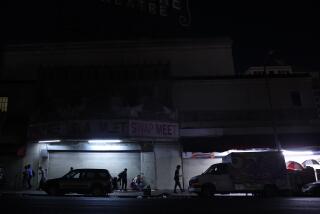Girl’s Shooting Escalates Pacoima Gang Fears
PACOIMA — Residents near Hubert H. Humphrey Park expressed concern and frustration--but not surprise--Monday over recent incidents of gun violence, including an apparent gang shootout that wounded a 9-year-old girl as she watched television with her father.
“There’s a shooting every 15 days or so,” said Maria L. Reyna, who lives a block from where gang members in two cars shot at one another about 10:30 Saturday night. A stray bullet struck the Broadous Elementary School student in the back as she sat inside her family’s Dronfield Avenue home. She was listed in fair condition Monday at Childrens Hospital.
Police said the incident may have involved members of a neighborhood gang and rivals from a graffiti crew.
On Sunday night, police said, a member of another gang sprayed semiautomatic gunfire at a house a few blocks away. Early last week, police shot and wounded a man who was waving a pellet gun at residents across Glenoaks Boulevard. All three incidents occurred within a roughly one-square-mile area.
Detectives and anti-gang patrol officers conducted door-to-door interviews Monday morning, looking for witnesses who would help identify possible suspects in the weekend shootings. No arrests have been made.
Reyna said that at least three times in the past year burglary suspects have run through her yard as they fled police.
“I always see boys out here at night drinking . . . or smoking marijuana,” Reyna whispered, pointing at the sidewalk in front of her house.
“That’s how bad it’s gotten.”
Herbert Reagan, a resident of Pacoima for 61 years, said younger families moving into the neighborhood from gang-infested areas of Los Angeles have brought the violence with them.
“It’s the younger kids doing all the shooting,” Reagan said. “It’s been steadily getting worse for 30 years. The people that stay, stay because their houses are paid for, even though they know it’s crazy around here sometimes.”
Crime Is Down in Northeast Valley
Capt. John Egan of the Los Angeles Police Department’s Foothill Division said crime is down in the northeast Valley overall for the year, though it has held steady in the neighborhood where the shootings occurred.
Public perception that crime has increased is based on occasional spells of violence since June, he said.
Citywide, gang-related killings rose 84% in the first five months of this year compared with the same period a year earlier. More recent statistics were not available Monday, but already this year gangs that had previously been linked to slayings in South Los Angeles, Compton and Watts have been implicated in northeast Valley killings, police said.
Foothill Division Det. Kandi Schmidt said neighbors as well as other gang members often refuse to testify because they fear retaliation.
The house shot at Sunday night has been the target of drive-by shootings at least five times, but its residents won’t speak up against the shooters, Schmidt said.
“Eventually somebody’s going to get killed there,” she said. “Those AK [-47] bullets just rip through walls.”
In her four years in the division’s special enforcement unit, Schmidt said, the number of gang “sub-units” in the area has grown from 30 to about 60. Some police officials, however, said the increase has been less drastic.
Neighbors and police have plenty of theories about why gang violence has persisted in north Pacoima.
Gangs know the Rampart scandal has cooled the LAPD’s aggressive anti-gang units, Schmidt said.
One resident said neighbors don’t know one another’s children well enough to discipline them. A former gang member who is now an activist said youngsters now joining gangs do not feel bound to honor a peace treaty signed seven years ago by 75 San Fernando Valley gangs.
“All the gangbangers who signed the treaty have grown up and have jobs, or they’re in jail,” said Steve Martinez, one of the initiators of the Valley Unity Peace Treaty signed in 1993.
“We can’t even call it a peace treaty anymore. We call it a peace effort, with these young kids who were in elementary school when the truce was signed getting into skirmishes now.”
Martinez, associate director of the nonprofit gang-intervention organization Communities in Schools, said a new wave of gangsters is emerging from usually nonviolent cliques of taggers--groups whose primary function is spray-painting their names in graffiti on buildings and signs.
Gangs Absorb Tagger Crews
“Sometimes hard-core gang members consider taggers to be punks, so they pick on them or maybe start a fight with them,” Martinez said. “The taggers live in the same neighborhood as the gangsters and feel like they might have to pack [a gun] to protect themselves from the gangsters.”
Martinez said his organization attempts to intervene before rival factions come to violence.
The police, too, have noticed tagger crews being absorbed by established gangs.
“This is different from the traditional recruiting for gangs,” Egan said. “Gang recruiting now runs the gamut. Some of these taggers may be forced into choosing between borderline criminal activity and affiliating with the gang.”
A number of city agencies have directed resources at curbing the criminal element near Humphrey Park, which the neighborhood reclaimed from gang control in 1997.
The Foothill Division has beefed up its anti-gang unit, Mayor Richard Riordan has committed funds to refurbishing the park, and City Councilman Alex Padilla had a slide installed at the swimming pool in an effort to increase park use.
“This is another tragic reminder we can never do too much in providing positive opportunities for youth and ensuring a high level of safety for residents throughout the city,” said David Gershwin, a spokesman for Padilla.
“We’ve seen a turnaround at Hubert Humphrey Park. The fact that this shooting happened so close to the park is a horrible coincidence, but our parks are no longer the hotbed of gang activity they once were.”
More to Read
Sign up for Essential California
The most important California stories and recommendations in your inbox every morning.
You may occasionally receive promotional content from the Los Angeles Times.










